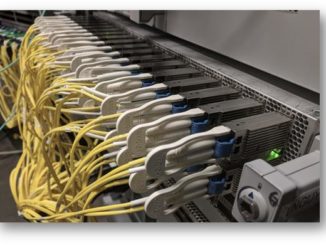
While the COVID-19 pandemic still has a grip on the world –the global seven-day average number of deaths was at 1,660 this past week – the chaotic days of early 2020 seem to get smaller in the review mirror. For many people, though, life, while assuming an increasing level of normalcy, has permanently changed, whether it’s in how they live or how they work.
Many companies also have changed how they operate, from having to deal with a more remote hybrid workforce to adapting to supply chains that have yet to completely rebound from the battering they took during the pandemic.
This put a strain on IT administrators. As Ben Baker, senior director of cloud and datacenter marketing and business analysis at Juniper Networks, tells The Next Platform, two years after the onset of the public health emergency, organizations are still figuring out how to respond to the changes. The labor supply issues they have to deal with are real, with people moving onto other careers, finding new IT jobs, or getting out of the workforce altogether.
Supply chain uncertainties mean that enterprises need to be reach to embrace multiple vendors in areas where they traditionally might have only needed one. Those relying on a single datacenter hardware supply are asking for trouble, Baker says.
“At best, they’re vulnerable to unexpected price increases,” he says. “At worst, a sudden supply difficulty could be crippling. As a datacenter operator, have you gotten a project budgeted and you go to place the order and the lead times mean you’ll get the gear five months after never? What if you could use the same design and have the option to get gear from multiple vendors?”
Christian Gilby, senior director of product marketing at Juniper, says that while speaking at a recent Juniper event, an EMEA customer echoed what others had told the networking company, that what had become key was “being able to manage a multi-vendor network. If they hit supply chain issues, they can mix and match datacenter switching products. Another is you’ve got to be able to support multi-vendor as you’re looking at rolling out that.”
Under CEO Rami Rahim’s tenure for the past eight years, Juniper has been putting together the pieces to expand its enterprise business, making it a full partner with its telco and service provider operations to grow its presence in the highly competitive networking space. That included buying AI and WLAN firm Mist for $405 million in 2019, saying the combination of Mist’s AI-powered WLAN and Junipers LAN, software-defined WAN (SD-WAN), and security offerings would enhance its enterprise networking portfolio.
A year later, Juniper bought Apstra, an intent-based networking startup that uses software to monitor and analyze network telemetry data to ensures the intent of network operators and to automatically configure and run datacenter networks.
Intent-based networking, which brings efficiency and automation to a dynamic networking and cloud spaces, has been championed by the likes of Cisco, IBM, and Veriflow Systems and is expected to grow as a market an average of more than 21 percent a year to 2030, when it will hit $6.2 billion.
Rahim over the years has been vocal about wanting to be a larger player in the enterprise networking space. 650 Research analyst Chris DePuy in 2019 outlined the vendor’s intention, noting the investments in such areas as 400 Gb/sec Ethernet, 5G, and multicloud and the expansion of the Mist AI engine to other parts of the portfolio, such as campus and branch switching and routing, adding that “customers will see the value of automation and intelligence throughout the enterprise product line.”
In the first quarter this year, Juniper’s enterprise business finally outpaced its service provider and cloud units, generating $433 million in revenue to $428 million in service provider and $307 million in cloud.
Apstra has been an important part of this, according to Baker and Gilby. Juniper has been building on its capabilities. Earlier this year, the vendor extended the software’s intent-based networking to smaller edge datacenters via support for collapsed fabric topologies used in such facilities. The enhancements also enabled tighter zero-trust security, a key enterprise concern as IT environments become more decentralized.
Apstra customers include Bloomberg, Vodafone, and T-Systems.
Juniper this month introduced Apstra Freeform, bringing the ability for enterprise, telcos, and cloud users to manage and automate their networks regardless of the topologies or the vendor used. It includes a new reference design that covers any protocol, topology, or reference domain and becomes a single source of truth for any network. There also is a new licensing model, with three tiers and the ability to upgrade at any time.
“Uncertainty defines our times right now,” Baker says. “Companies are looking for IT and networking tools that can help them adapt and respond quickly to unexpected change. Unlike virtual machines, people are not fungible. Can your NetOps teams switch from the vendor syntax of Cisco to Arista or Juniper hardware seamlessly? With Apstra managing the DC fabric they can. IT teams need a solution that gives them the flexibility to innovate freely without vendor and technology lock in.”
Previously, Apstra offered purpose-built reference designs, he says. It was a heavily curated experience that included guardrails for three- or five-stage EVPN-VXLAN spine-leaf fabrics or collapsed fabric datacenter architectures. He refers to Apstra Freeform as an “anything-goes” reference design.
Such capabilities enable Juniper to address the enterprise needs that have come out of the pandemic, which rapidly changed how people work and accelerated what already was a strong trend toward cloud adoption. All of that created an uncertain IT and business environment.
“As we kind of emerged from the pandemic and sort of get back to normal, it’s the acceleration of uncertainty and variability of the human beings who might go into the office and might not,” he says, adding that Apstra allow some organizations “to go with another hardware vendor who might not have been their first choice, but that hardware vendor presented them with lead times for their switches that were much shorter than the other vendor. … There are a lot of opportunities for us that have sprung up.”
Juniper has looked to the large datacenter operators as it has evolved Apstra, Baker says.
“Enterprises are learning from the hyperscalers who have mastered the efficient operation of massive datacenter networks,” he says. “Everyone thinks that the hyperscalers move really fast. And they do. But their starting point is not speed in a narrow sense. Their starting point has been reliability. To get reliable operations you need consistency, repeatability. These are the principles that have guided the Juniper Apstra product roadmap. And interestingly, if you focus first on reliability, the outcome actually is speed.”





Be the first to comment